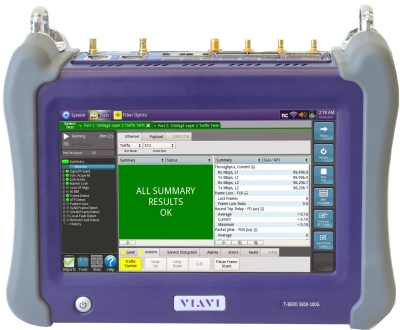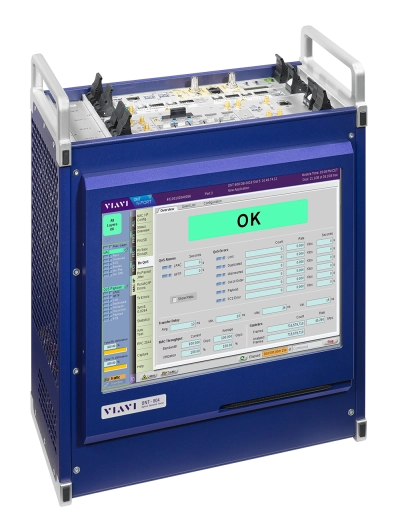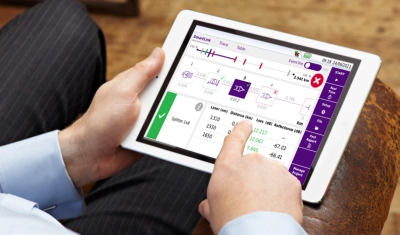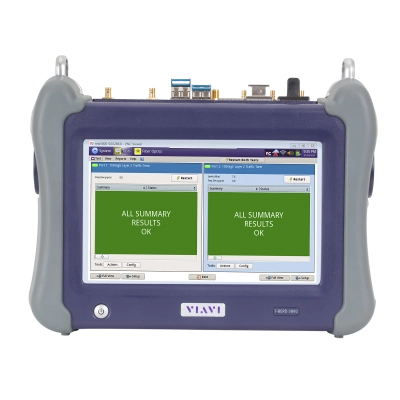Bit Error Rate Test (BERT)
State-of-the-art bit error rate testers from VIAVI
Whether you are looking for the smallest handheld 100G bit error rate tester in the world for your field job, or perhaps your needs take you into the lab, VIAVI has you covered with our accurate and easy-to-use BERT equipment for any use case.
Products
-

T-BERD/MTS-5800-100G Platform
The T-BERD/MTS-5800-100G handheld network tester is the one tool that network technicians and engineers need to...
-

MAP-2100
The one tool data center operators need to remotely test transmission quality of the network connecting its data...
-

ONT-800
Highly configurable, multi-protocol, multi-port test platform for R&D and system verification of optical...
-

ONT 800G FLEX Module
Accelerate development for PAM-4 based products and flexible services up to 800G
-

OneAdvisor 800 Transport Platform
Field-ready network test platform up to 800G
-

Smart Access Anywhere (SAA)
A solution that enables centralized support, on-demand test and live results analysis to support and coach...
-

T-BERD/MTS-5800 Platform
This tester is the industry’s smallest 10G handheld instrument and supports testing throughout the entire service...
Bit Error Rate Testing
Bit Error Rate (BER) is a measure of telecommunication signal integrity based on the quantity or percentage of transmitted bits that are received incorrectly. Essentially, the more incorrect bits, the greater the impact on signal quality. Bit error rate is an effective indicator of full end-to-end performance because it encompasses the receiver and transmitter as well as the media between them.
What is Bit Error Rate Testing (BERT)?
Bit error rate testing (BERT) can be used to quantify BER for fiber optic networks, Ethernet, or any other system used to transmit data. To perform a bit error rate test, a pre-defined data stream is sent through a network link input, then the output of the link at the receiving end is analyzed to assess the number of errors detected versus the number of bits transmitted over a given time frame.
A Pseudorandom Binary Sequence (PRBS) can be used to create a data transmission pattern likely to cause errors by producing a wide range of bit patterns. This acceleration of induced errors is useful for reducing the BER test time but can only be utilized on lines which are out-of-service. Whether you are verifying the performance of your own network or performing service activation for a customer or client, BERT is an effective way to ensure overall network integrity.
Bit Error Rate Performance Metrics
The bit error rate is calculated by dividing the quantity of bits received in error by the total number of bits transmitted within the same time period. A result of 10-9 is generally considered an acceptable bit error rate for telecommunications, while 10-13 is a more appropriate minimum BER for data transmission. If enough confidence in the rate is established, it can also be expressed as a probability (Pe) of errors occurring in the future. An effective bit error rate tester can perform service activation testing for several key performance indicators (KPIs).
Closely related to the bit error rate is the packet error rate (PER). Since each packet is essentially a collection of bits, the PER is analogous to the ratio of busses that do not reach their destination if the BER was determining the same ratio for all passengers. Measuring packet loss is essential because significant loss of packets can lead to slow service or network disruption. Network congestion, overutilized devices and network hardware problems, such as outdated firewalls are some of the causes of packet loss. In some cases, packet loss can be also be leading indicator of security issues, including denial of service (DOS) attacks.
Latency in network performance is a measure of delay, which can be quantified based on the time it takes for data to travel from one location to another. Latency is an important QoS metric because high latency can lead to bottlenecks resulting in poor VoIP quality and generally sluggish communication. Excessive latency can also directly impact throughput since it can cause the TCP window to fill too slowly. Common factors contributing to network latency include fiber run lengths, storage delays, and router/switching errors.
Since latency is not consistent, each packet will take a slightly different amount of time to move from start to finish. Jitter is defined as the variance in the delay of data packets received over the network. Too much variation between packets can be detrimental, particularly for voice and video transmission where the server must compensate for this jitter to make the media discernable.
Excessive jitter can lead to congestion or packet loss beyond the capability of the digital signal processor (DSP) to address it. This might result in audio signal dropouts or pixelated video transmission.
The Importance of Bit Error Rate Testing
With the bandwidth and performance demands on Ethernet networks increasing daily, BERT has become essential for quantifying bit error rate in optical fiber communication channels and establishing confidence in high speed service activation. The importance of BERT encompasses both internal and external customers.
Performing BERT testing on internal networks can ensure clean and efficient operation, especially when large circuits carrying high levels of traffic are deployed. Moreover, customers purchasing high speed networks expect flawless performance from day one. Bit error rate testing can be used to certify the operation of new networks, thereby enhancing customer satisfaction levels.
Bit errors in fiber networks can result from attenuation, dispersion, and numerous other root causes, but Ethernet error checking and correction routines can potentially mask physical issues inherent to the network, leading some to conclude that BERT is not necessary for Ethernet-based fiber optic links. On the contrary, the retransmitted packets resulting from bit errors can effectively truncate the throughput performance and inadvertently contribute to congestion issues. While the network may appear to be functioning optimally, the potential consequences of omitting bit error rate testing include lack of in-depth system performance visibility and lost opportunities for pre-activation corrections.
Types of Bit Error Rate Tests
Several BERT test for Ethernet and service activation methods have been developed, each with inherent advantages and limitations. While some test processes are well suited for specific applications, others provide a more general assessment of the network link QoS.
The RFC 2544 test was developed by the IETF in 1999 for the benchmarking of network elements in a lab setting. This test methodology was adapted for field use because no other standardized Ethernet based service activation test was available to providers. The title, “Benchmarking Methodology for Network Interconnect Devices”, provides an apt description of the test and its intended use for evaluating Layer 2 in the OSI model.
This test evolved into the industry standard service activation test for single-service Ethernet and IP, encompassing throughput, burstability, frame loss and latency KPI’s. VIAVI’s enhanced version of the RFC 2544 test protocol reduces testing time by 66% by running tests concurrently.
The Y.1564 standard was developed for field use and provides complete validation of Ethernet service level agreements (SLA) within a single test. Y.1564 is the industry standard service activation test for multi-service Ethernet and IP, aka “triple-play”. The test is performed over data link Layer 2 in the OSI model. Unlike RFC 2544, Y.1564 compares KPIs to expected levels, rather than simply quantifying maximum capabilities, and can test multiple logical streams independently on a circuit. Test streams aligned with the Metro Ethernet Forum (MEF) 10.2 definitions are used to simulate real world network traffic scenarios during the testing.
While RFC 2544 and Y.1564 have proven to be effective, they do not include performance testing over the transmission control protocol (TCP) or application layers. Since most web based or cloud based applications run over TCP, IETF RFC 6349 provides a higher level testing option. Metrics for RFC 6349 include TCP transfer time, TCP efficiency, based on retransmissions as a percentage of the overall TCP payload bytes, and Buffer Delay Percentage (BDP), which compares the round-trip time (RTT) during TCP transfer to a baseline established without network congestion.
Bit Error Rate Test Equipment
The development of BERT test tools and equipment has mirrored the progression of the test process from the lab setting through manufacturing and into the field. The diverse VIAVI bit error rate test equipment offerings support this unbroken chain with industry leading lab, handheld and rack-mounted testing equipment.
In the lab, engineers and scientists require test solutions with the versatility, scalability and modularity needed to develop and test cutting edge network equipment and components. The ONT product family incorporates a wide range of application modules, all operated through a highly functional touchscreen GUI. Developers of all major optical transport technologies can leverage this flexibility to simulate anomalistic traffic and error conditions and fully evaluate newly designed networking components operating up to 400G and beyond.
The ONT series can facilitate sophisticated system verification testing (SVT) as new network products transition from R&D into production. Efficient use of power and automation support make the ONT family equally well-suited for production testing, from low volume through the entire product life cycle.
To complete the progression from conceptualization in the lab to fully deployed network in the field, compact, powerful, handheld network testers with clear pass/fail results ensure successful network and equipment activation and maintenance.
The T-BERD/MTS-5800-100G is the world’s smallest handheld 100G all-in-one bit error rate tester and also produces the industry’s fastest RFC 2544 and Y.1564 service activation test when coupled with the SAMComplete test solution. This test instrument supports RFC 6349 TrueSpeed testing and numerous other test applications including fiber link characterization and synchronization testing.
The T-BERD/MTS-5800 is a handheld 10G network tester that can also be utilized for automated Ethernet service activation. The T-BERD/MTS series is fully optimized for efficiency in the field with multitouch screens and scripted workflows. The interface is highly expandable with optional OTDR, optical power meter and fiber end face inspection modules available.
End-to-end BERT typically requires technicians with handheld instruments located at both ends of the circuit. In many cases, data centers will have limited resources available to facilitate this testing. For these situations, rack mounted bit error rate test equipment can enable testing from only a single end of the circuit. The MAP-2100 tester is optimized for remote, unmanned Ethernet testing with 1G through 100G line rates. BERT can also be completed entirely remotely when necessary, using a MAP-2100 at each location with tests run via secure communication channels.
Bit Error Rate Testing Tutorials
The benefits of bit error rate testing are plentiful, although completing the tests is sometimes perceived as an arduous and highly involved process. VIAVI has made performing a BER test easier, faster and more intuitive by creating pre-defined test routines and configurations. The below BERT tutorials and literature can help make your testing experience even more seamless.
Solution briefs are available for each standard test to highlight the cutting-edge enhancements and advantages VIAVI has pioneered. For RFC 2544 Ethernet service activation, test components include concurrent test processes, long term “soak” testing and an integrated J-QuickCheck pretest to assess basic throughput and connectivity.
The solution brief for Y.1564 testing emphasizes 100% bandwidth configuration testing to reduce test time, realistic triple-play emulation for real world traffic simulation and a wide variety of available loop backs for added flexibility. The SAMComplete test suite also provides the only available solution for concurrent Y.1564 and RFC 6349 testing to support automated and efficient TCP throughput testing.
Watch the on-demand webcast series: The Essentials of Ethernet Service Activation Series
Expert commentary and guidance on bit error rate testing best practices and Ethernet service activation can be found in a free webinar series offered by VIAVI. These webinars provide detailed technology descriptions from the ground up and the insightful up-to-date advice that can only be garnered from distinguished subject matter experts.
Do You Need Bit Error Rate Testing?
The invaluable empirical results obtained from end-to-end network performance testing once required a commensurate level of time, equipment and manpower to produce, but this is no longer the case. Automated test routines, user-friendly, compact equipment and innovative test protocols to maximize efficiency have removed the roadblocks that once made BERT testing an elective activity. High performing networks and highly satisfied customers are the indisputable benefits of bit error rate testing that can propagate for years to come.
Support at Every Step
We provide support, services, comprehensive training and the resources you need. It’s all part of what we do to maximize the value of your VIAVI investment.
Ask an Expert
Contact us for more information or to receive a price quote. We have the experts to give you the right answer on any of your questions.







